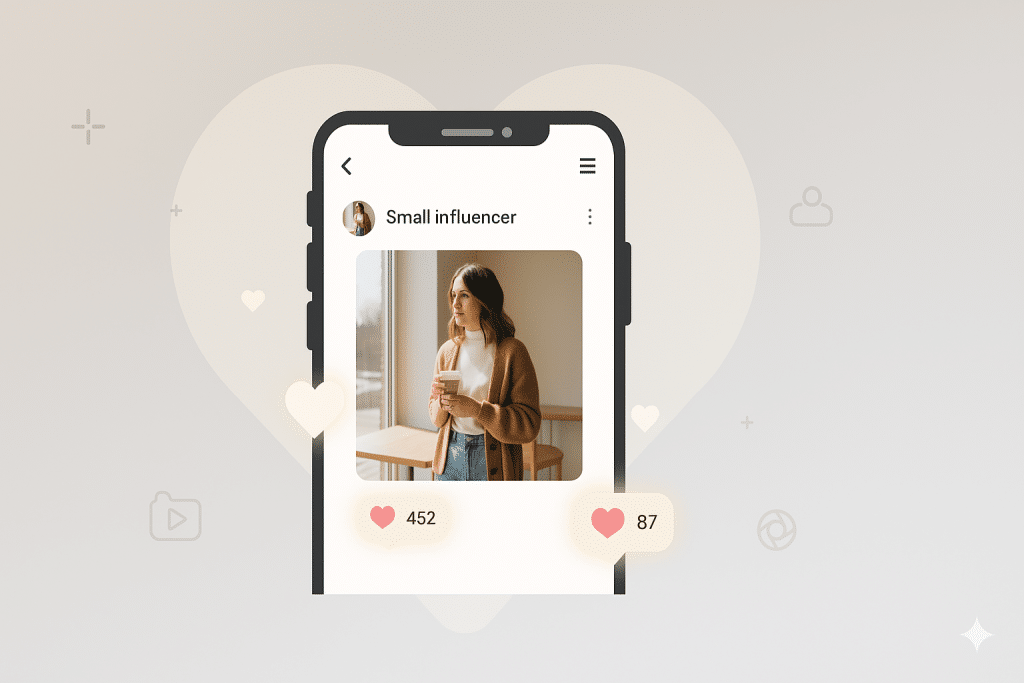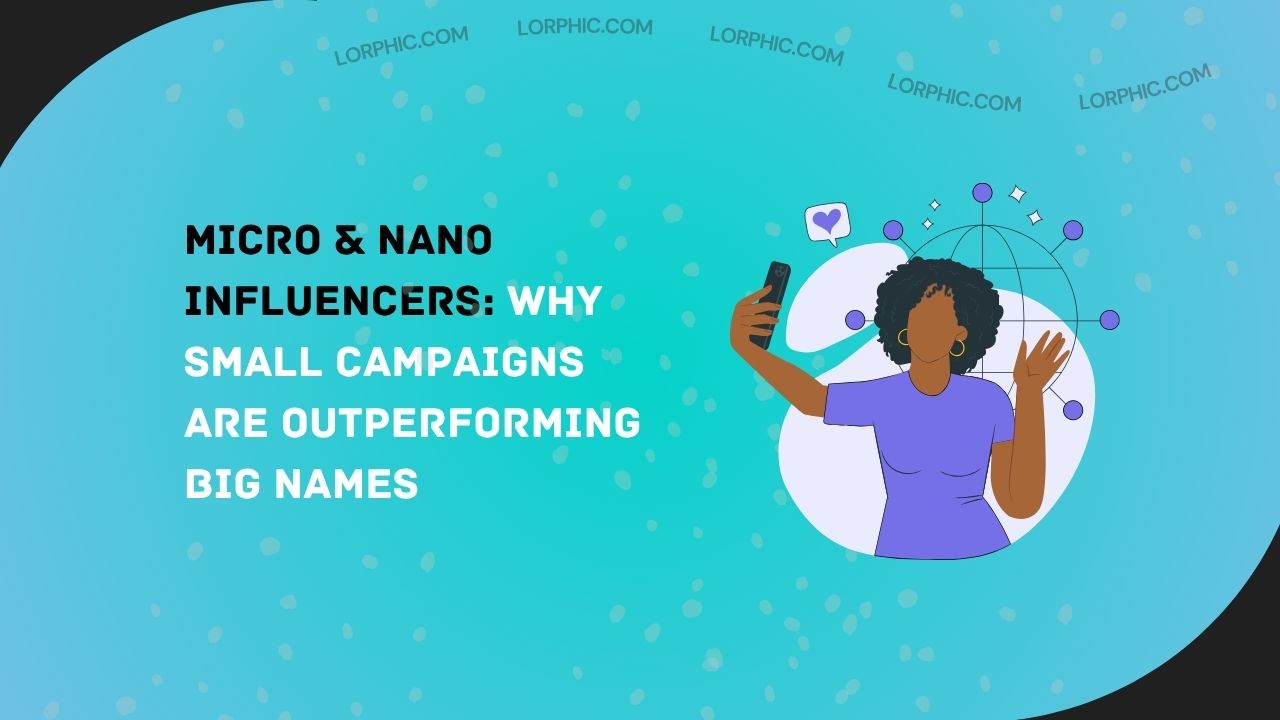Imagine spending a fraction of your budget and getting twice the engagement that’s the quiet revolution of working with Micro & Nano influencers.
In an era where big-name influencers dominate headlines and ad spends, smart marketers are quietly shifting to a different strategy: targeting the smaller, more intimate voices of the influencer ecosystem. The reason? Real people, real trust and real results.
In this article we’ll explore why campaigns with smaller-scale creators are frequently outperforming campaigns with major influencers, backed by real data, actionable insights for your digital marketing strategy, and concrete steps your agency can take today.

What are Micro & Nano influencers?
Before we dive into performance and strategy, let’s clarify terms:
- Nano-influencers: Typically, creators with ~1,000 to 10,000 followers.
- Micro-influencers: Creators with ~10,000 to 100,000 followers.
- These differ from macro-influencers (hundreds of thousands of followers) and mega/celebrity influencers (millions).
The important thing to remember : smaller follower count does not mean weaker results. In fact, many studies suggest the opposite when it comes to engagement, authenticity, and cost-effectiveness.
The Case for Micro & Nano: Data That Speaks
Engagement rates
- According to a Social Cat report, nano-influencers (1K-10K followers) have an average engagement rate of 2.71%, while micro-influencers (10K-50K) manage ~1.81%.
- Similarly, Paul M. Katz analysis revealed that micro-influencers on Instagram often reach engagement rates as high as 3.86%, whereas mega influencers typically fall to just 1.21%.
- On Instagram, a benchmark review found nano influencers achieve ~2.19% engagement, while micro influencers (10K-50K followers) average ~0.99%.
- On TikTok, nano-influencers (<10K followers) showed an average engagement rate of 10.3%, far higher than bigger influencers.
Cost & ROI
- Brands on Instagram reportedly get on average $4.12 for every $1 spent on influencer campaigns.
- Because smaller creators are more cost-effective (often lower fees or product-only collaborations), brands can invest in multiple nano/micro creators rather than a single expensive star.
Authenticity, niche and trust
- Nano influencers are often seen as more relatable and trustworthy “real people” with whom their followers feel a connection.
- Smaller creators tend to have a tighter, more engaged community, enabling more meaningful interactions (comments, replies, stories) rather than passive “views”.
Brand preference
- 61% of brands reported that their primary influencer strategy involves nano- and micro-influencers.
- Nano-influencers accounted for ~75.9% of Instagram’s influencer base in 2024.
Why smaller campaigns often outperform big-name influencer campaigns
1. Higher engagement relative to audience size
Larger follower counts come with diminishing returns: as an account grows, follower engagement tends to drop. Smaller influencers maintain more consistent, meaningful interaction.
2. Authentic voice & relatable content
When an influencer has 2,000–10,000 followers, their content feels more peer-to-peer. The recommendation doesn’t feel like an ad it feels like a friend. That authenticity boosts trust and conversion.
3. Niche targeting
Micro and nano influencers often operate within specific niches (e.g., vegan skincare, eco-travel, local fitness). Their audiences are highly aligned with those niches meaning brands can hit relevant segments rather than a broad generic audience.
4. Cost-effectiveness & scalability
Because each nano or micro influencer costs less, you can spread your budget among multiple creators diversifying risk, reaching different audience pockets, and generating multiple pieces of unique content. This strategy often yields better ROI than backing a single big name.
5. Easier collaboration & agility
Smaller creators tend to manage their own accounts, respond faster, accept product-only deals, and produce content quickly which makes campaign management simpler and more flexible.
When Big Influencers Still Make Sense
Now, it’s important to acknowledge: large-scale influencers and macro/mega campaigns still have a place. Their strength lies in broad awareness, massive reach, and splashy launches. For example:
- A global brand launching a flagship product with huge ad spend might still opt for a celebrity influencer to grab attention.
- When the objective is simply “get in front of as many eyes as possible” rather than driving niche engagement or conversion, bigger names can be appropriate.
However, for many brands particularly those with mid-sized budgets or niche audiences micro & nano influencer campaigns deliver a more efficient, relatable, and effective solution.
Practical Strategy: How to Build a Winning Micro/Nano Campaign
Here’s how your digital marketing agency (or you, as a brand) can put this into action.
Step 1: Define your goal & audience
- Are you trying to drive conversions, build brand awareness, or boost community sentiment?
- What is your niche or target segment? (E.g., “eco-friendly travel enthusiasts aged 20-35 in the US”)
- Smaller influencers are powerful when their audience overlaps tightly with your target.
Step 2: Identify the right influencers
- Focus on micro influencers (10K-100K followers) and nano influencers (1K-10K followers).
- Prioritize creators whose niche matches your target, and whose engagement rate is strong (look beyond follower count).
- Use metrics: engagement rate, follower quality (real vs bot), content style, authenticity.
- Example benchmarks: nano-influencers may get ~2.5%-10% engagement depending on platform.
Step 3: Structure your campaign for authenticity
- Encourage content that feels personal: “Here’s how I use product X in my everyday life.”
- Use product gifting, affiliate links, or commission-based partnerships (especially with nano influencers) for better performance.
- Provide creative guidelines but allow influence-creator freedom so content doesn’t feel forced.
Step 4: Repurpose and amplify the content
- One major benefit: content produced by micro/nano influencers can be reused across your channels (social ads, email, website). 60% of marketers say influencer-generated content outperforms brand-directed content.
- Track key metrics: engagement rate (likes, comments, shares), conversion (clicks, sign-ups, purchases), cost-per-engagement, cost-per-conversion.
Step 5: Scale with multiple influencers rather than one “big name”
- Instead of a single macro influencer, consider 5-10 nano/micro influencers working in tandem. This spreads reach and gives more authentic voices across diverse pockets.
- Test: Use smaller creators first, measure results, then scale or expand into larger creators if needed.
Step 6: Measure, iterate & build relationships
- Influencer marketing is not “set and forget”. Monitor performance, gather insights (what content style worked, which audience reacted), refine your approach.
- Build long-term relationships with creator’s older campaigns show better ROI when influencers are treated as brand ambassadors rather than one-off partners.
Common Pitfalls & How to Avoid Them
Pitfall 1: Chasing follower count instead of relevance
Don’t assume that 100K followers = better results. A creator with 5K followers but 8% engagement might outperform a 200K-follower account at 1% engagement. Always look beyond the number.
Pitfall 2: Ignoring authenticity
When content feels forced, the audience senses it. Authentic, relatable voice matters. Ensure the influencer genuinely uses or believes in your product/brand.
Pitfall 3: Not tracking proper metrics
Focusing only on impressions or likes misses the point. For smaller influencers, conversions (clicks, sign-ups, purchases), engagement quality (comments, shares), and cost-per-engagement matter more.
Pitfall 4: Single large influencer only
Putting your entire budget into one big name may risk high cost and low trust. Diversification with multiple smaller influencers often gives better ROI.
Pitfall 5: One-and-done collaborations
Influencer marketing is increasingly about community building and long-term partnerships. Brands that build ongoing programs with creators benefit from stronger trust and better reuse of content.
How This Applies to Your Digital Marketing Agency & Your Clients
If you run or work for a digital marketing agency (just like you, Giovanni), here’s how to advise your clients:
- Highlight the case for micro & nano influencer campaigns as a key part of their media mix especially when budgets are moderate or target audiences specific.
- Use the data above (engagement rates, cost-effectiveness) to build your pitch: smaller-scale influencers offer higher interactions and better alignment.
- Structure your influencer strategy in tiers:
- Tier A: Nano influencers highly niche, high engagement, lower cost.
- Tier B: Micro influencers moderate audience size, still strong authenticity.
- Tier C: Macro influencers use only when objective is broad reach/awareness.
- Show clients that influencer campaigns are not just “post & hope” they require clear goals, metrics, measurement, and content reuse.
- Recommend a mix of content: influencer posts, influencer-generated content reused in ads, long-term creator partnerships, affiliate links or trackable codes.
- Use technology and tools to vet influencers (engagement, audience authenticity, brand fit) and to track performance over time.
By positioning micro & nano influencer campaigns as both cost-efficient and high-impact, your agency can offer clients strategic edge leveraging the authenticity of smaller creators rather than relying solely on big names that may deliver reach but not necessarily engagement or conversions.
Looking Ahead: Trends in Influencer Marketing
Here are a few emerging trends tied to micro & nano influencers:
- Brands will increasingly allocate budgets toward smaller creators and diversify their creator portfolios.
- Influencer-generated content (IGC) will be reused across owned and paid channels as brands look to maximize value.
- The concept of “creator economy” grows: nano creators become brand ambassadors, not just one-off collaborators.
- Micro & nano influencer campaigns become more data-driven: tracking conversion, lifetime value, deep audience metrics.
- As competition increases, smaller creators may begin increasing rates meaning brands and agencies must still maintain cost discipline and smart targeting.
Summary & Final Thoughts
The myth that bigger is always better doesn’t hold up when you look at the data in influencer marketing. Smaller, niche creators micro and nano influencers frequently deliver higher engagement, greater authenticity, and better cost-efficiency than large-scale influencer campaigns.
If your digital marketing agency is seeking to maximise performance for clients (or if you’re planning an influencer-driven side business), embracing the power of micro & nano influencers is one of the smartest strategic moves you can make.
Remember: it’s not just about how many followers someone has it’s about how deeply those followers are engaged, how well the influencer aligns with your brand’s audience and message, and how creatively you can activate campaigns that feel genuine.
Curated by Lorphic
Digital intelligence. Clarity. Truth.


